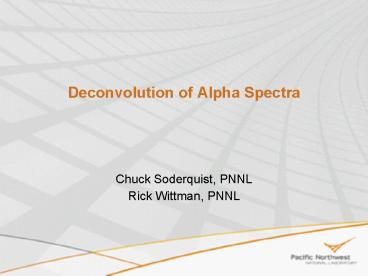Deconvolution of Alpha Spectra PowerPoint PPT Presentation
1 / 19
Title: Deconvolution of Alpha Spectra
1
Deconvolution of Alpha Spectra
- Chuck Soderquist, PNNL
- Rick Wittman, PNNL
2
Alpha Spectra
- Because alpha particles do not travel far through
matter, the counting mount must be as nearly
massless as possible. - Mass on the counting mount causes alpha particles
to lose energy and show up at the wrong place on
the spectrum.
3
Evaluation of Alpha Spectra
- Alpha spectra normally have tails on the low
energy side of the each peak. - Not Gaussian, and different from sample to
sample. - Closely spaced peaks often overlap, at least a
little. - When peaks overlap, simple integrations give
compromised results.
4
Americium Alpha Spectra
- Americium spectra are particularly susceptible to
inferior resolution, since Am-243 and Am-241 are
closely spaced. - No room for bad resolution.
- Negative error in Am-241 peak and positive error
in Am-243 peak add the same direction, causing a
consistent bias in the calculated Am-241 activity.
5
Good Americium Spectrum
- Lower peak doesnt have much tail, so upper peak
doesnt have much tail either. Overlap is very
small. - Simple integration is suitable.
6
Inferior Americium Spectrum
- Since the lower peak has a tail, the upper peak
must also have a tail, which extends under the
lower peak. - Cant accurately integrate the lower peak.
- Spike recovery is 88 using simple integration.
7
Deconvolution of the Peaks
- Draw in the tail of the upper peak. Make it an
exact copy of the lower peak, but scaled to the
size of the upper peak. (Use Excel,
channel-by-channel.) - Subtract the new tail from the raw spectrum to
get the lower peak.
8
Deconvoluted Peaks
- Now, both peaks can be integrated.
- Spike recovery is 101
- Can now integrate entire tail of each peak. No
part of the spectrum is ignored.
9
How we do this
- Copy the raw alpha spectrum into Excel, 1 channel
per row. Channel in column A, energy in column
B, raw counts in column C. - Label column D 3-channel running average. Use
the running average instead of raw counts. - Label two more columns for Am-243 and Am-241
10
Deconvolution, continued
Start Here
Calculate the new peak tail, channel by channel
New tail goes here
11
Deconvolution, continued
- Calculate the new Am-241 peak in its own column.
Force the Am-241 peak to have the same shape as
the Am-243 peak, scaled to the Am-241 peak
height. - Calculate the new Am-243 peak in its own column,
by subtracting Am-241 from the raw spectrum.
12
Deconvolution, continued
Start here, n channels down from top of peak
Find the point on the lower point which is also n
channels below the top of peak
Take the ratio of tail to peak. Multiply that by
the height of the other peak to calculate the new
tail.
13
Deconvolution, continued
Upper peak tail is an exact scaled copy of the
lower peak tail
14
Results of Deconvolution
88 spike recovery
101 spike recovery
15
Results of Deconvolution
99 of expected Am-241
104 of expected Am--241
16
Results of Deconvolution
83 of expected Am-241
99 of expected Am-241
17
Results of Deconvolution
75 of expected Am-241
93 of expected Am-241
18
Results of Deconvolution
97 of expected Am-241
97 of expected
19
(No Transcript)

